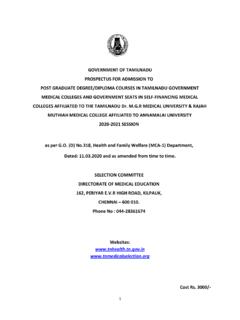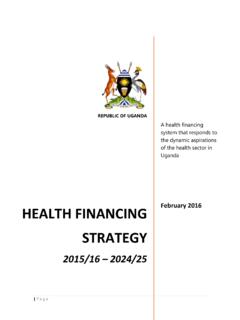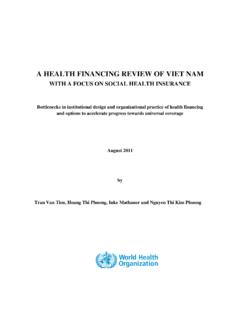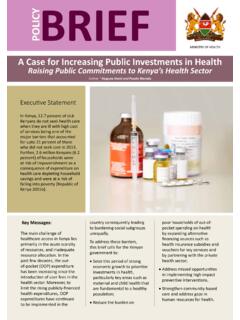Transcription of 2021 Medicare Trustees Report
1 2021 ANNUAL Report OF. THE BOARDS OF Trustees OF THE. FEDERAL HOSPITAL INSURANCE AND. FEDERAL SUPPLEMENTARY MEDICAL INSURANCE. TRUST FUNDS. COMMUNICATION. From THE BOARDS OF Trustees , FEDERAL HOSPITAL INSURANCE AND. FEDERAL SUPPLEMENTARY MEDICAL INSURANCE. TRUST FUNDS. Transmitting THE 2021 ANNUAL Report OF. THE BOARDS OF Trustees OF THE. FEDERAL HOSPITAL INSURANCE AND. FEDERAL SUPPLEMENTARY MEDICAL INSURANCE. TRUST FUNDS. LETTER OF TRANSMITTAL. _____. BOARDS OF Trustees OF THE. FEDERAL HOSPITAL INSURANCE AND. FEDERAL SUPPLEMENTARY MEDICAL INSURANCE TRUST FUNDS, Washington, , August 31, 2021. HONORABLE N ANCY PELOSI, Speaker of the House of Representatives HONORABLE KAMALA D. HARRIS, President of the Senate DEAR MADAM SPEAKER AND MADAM PRESIDENT : We have the honor of transmitting to you the 2021 Annual Report of the Boards of Trustees of the Federal Hospital Insurance Trust Fund and the Federal Supplementary Medical Insurance Trust Fund, the 56th such Report .
2 Respectfully, JANET YELLEN, MARTIN J. WALSH, Secretary of the Treasury, Secretary of Labor, and Managing Trustee of the Trust Funds. and Trustee. XAVIER BECERRA, KILOLO KIJAKAZI, Secretary of Health and Human Services, Acting Commissioner of Social Security, and Trustee. and Trustee. VACANT, VACANT, Public Trustee. Public Trustee. CHIQUITA BROOKS-LASURE, Administrator, Centers for Medicare & Medicaid Services, and Secretary, Boards of Trustees . (III). CONTENTS. I. INTRODUCTION .. 1. II. OVERVIEW .. 8. A. 8. B. Medicare Data for Calendar Year 2020 .. 12. C. Medicare Assumptions .. 14. D. Financial Outlook for the Medicare 20. E. Financial Status of the HI Trust 26. F. Financial Status of the SMI Trust 32. G. Conclusion .. 41. III. ACTUARIAL ANALYSIS .. 44. A. Introduction .. 44. B. HI Financial Status .. 45. 1. Financial Operations in Calendar Year 45. 2. 10-Year Actuarial Estimates (2021 2030).. 52. 3. Long-Range 62.
3 4. Long-Range Sensitivity 74. C. Part B Financial 80. 1. Financial Operations in Calendar Year 80. 2. 10-Year Actuarial Estimates (2021 2030).. 88. 3. Long-Range 102. D. Part D Financial Status .. 104. 1. Financial Operations in Calendar Year 104. 2. 10-Year Actuarial Estimates (2021 2030).. 108. 3. Long-Range 116. IV. ACTUARIAL METHODOLOGY AND PRINCIPAL ASSUMPTIONS 119. A. Hospital Insurance .. 119. B. Supplementary Medical Insurance .. 131. 1. Part B .. 131. 2. Part D .. 143. C. Private Health 154. D. Long-Range Medicare Cost Growth 164. V. APPENDICES .. 172. A. Medicare Amendments since the 2020 172. B. Total Medicare Financial Projections .. 188. C. Illustrative Alternative Projections .. 200. D. Average Medicare Expenditures per 205. E. Medicare Cost-Sharing and Premium Amounts .. 208. F. Medicare and Social Security Trust Funds and the Federal Budget .. 216. G. Infinite Horizon 223. H. Fiscal Year Historical Data and Projections through 2030.
4 230. I. Glossary .. 241. J. List of Tables .. 261. J. List of 265. J. Statement of Actuarial Opinion .. 266. (V). I. INTRODUCTION. The Medicare program helps pay for health care services for the aged, disabled, and individuals with end-stage renal disease (ESRD). It has two separate trust funds, the Hospital Insurance trust fund (HI) and the Supplementary Medical Insurance trust fund (SMI). HI, otherwise known as Medicare Part A, helps pay for inpatient hospital services, hospice care, and skilled nursing facility and home health services following hospital stays. SMI consists of Medicare Part B and Part D. Part B helps pay for physician, outpatient hospital, home health, and other services for individuals who have voluntarily enrolled. Part D. provides subsidized access to drug insurance coverage on a voluntary basis for all beneficiaries and premium and cost-sharing subsidies for low-income enrollees. Medicare also has a Part C, which serves as an alternative to traditional Part A and Part B coverage.
5 Under this option, beneficiaries can choose to enroll in and receive care from private Medicare Advantage and certain other health insurance plans. Medicare Advantage and Program of All-Inclusive Care for the Elderly (PACE) plans receive prospective, capitated payments for such beneficiaries from the HI and SMI Part B trust fund accounts; the other plans are paid from the accounts on the basis of their costs. The Social Security Act established the Medicare Board of Trustees to oversee the financial operations of the HI and SMI trust funds. 1 The Board has six members. Four members serve by virtue of their positions in the Federal Government: the Secretary of the Treasury, who is the Managing Trustee; the Secretary of Labor; the Secretary of Health and Human Services; and the Commissioner of Social Security. Two other members are public representatives whom the President appoints and the Senate confirms. These positions have been vacant since 2015.
6 The Administrator of the Centers for Medicare & Medicaid Services (CMS) serves as Secretary of the Board. The Social Security Act requires that the Board, among other duties, Report annually to the Congress on the financial and actuarial status of the HI and SMI trust funds. The 2021 Report is the 56th that the Board has submitted. With one exception, the projections are based on the current-law provisions of the Social Security Act. The one exception is that the Part A projections disregard payment reductions that would result from the projected depletion of the Medicare HI trust fund. Under 1 The Social Security Act established separate boards for HI and SMI. Both boards have the same membership, so for convenience they are collectively referred to as the Medicare Board of Trustees in this Report . 1. Introduction current law, payments would be reduced to levels that could be covered by incoming tax and premium revenues when the HI trust fund was depleted.
7 If the projections reflected such payment reductions, then any imbalances between payments and revenues would be automatically eliminated, and the Report would not fulfill one of its critical functions, which is to inform policy makers and the public about the size of any trust fund deficits that would need to be resolved to avert program insolvency. To date, lawmakers have never allowed the assets of the Medicare HI trust fund to become depleted. Beginning in 2020, the Medicare program was dramatically affected by the COVID-19 pandemic. The amount of payroll taxes expected to be collected by the HI trust fund was greatly reduced due to the economic effects of the pandemic on labor markets. Spending was directly affected by the coverage of testing and treatment of the disease. In addition, several regulatory policies and legislative provisions were enacted during the public health emergency that increased spending.
8 Notably, the 3-day inpatient stay requirement to receive skilled nursing facility services was waived, payments for inpatient admission related to COVID-19 were increased by 20 percent, and the use of telehealth was greatly expanded. More than offsetting these additional costs in 2020, spending for non-COVID care declined significantly (compared to both actual 2019 spending and expectations for 2020. spending in last year's Trustees Report ). This decline was particularly true for elective services. Overall, the projections are based on actual experience through 2019. To account for the spending impacts of the pandemic, adjustment factors by type of service were developed through 2023. These factors are based on (i) projections of the pandemic; (ii) direct costs associated with the testing and treatment of COVID-19; (iii) projections for non- COVID costs; and (iv) costs for the vaccines. Certain services, such as prescription drugs, durable medical equipment, physician- administered drugs, and hospice, were not materially affected by the pandemic.
9 Because of the large wave of COVID-19 cases in early 2021, non- COVID-related spending is estimated to be lower than previously expected for the beginning of the year. As care that was reduced or deferred returns, the trend in the latter part of 2021 is slightly higher than anticipated previously. For 2022, the return of deferred care that is assumed to be more intensive results in spending that continues to be higher than previously estimated. The Trustees have not included any longer-term morbidity impacts, balancing (i) a potential increase in costs due to longer-lasting health needs from those who have had 2. Introduction COVID-19 with (ii) a potential reduction in costs due to the higher mortality from COVID-19 among those with higher medical spending. The estimates in this year's Report also incorporate the costs of the COVID-19 vaccines, which consist of both the payments for the vaccines themselves and the payments for their administration.
10 The Trustees expect vaccine utilization to decrease somewhat over time, reflecting the likely reduction in the required number of doses and the possibility that the seriousness of COVID-19 will decrease. It should be noted that there is an unusually large degree of uncertainty with these COVID-related impacts and that future projections could change significantly as more information becomes available. The Medicare Accelerated and Advance Payments (AAP) Program was significantly expanded during the COVID-19 public health emergency period, by both legislative provisions and through administrative actions taken by CMS early on during the emergency. CMS first implemented an expedited process for eligible providers and suppliers to request and receive approval for these payments. Next, while the Coronavirus Aid, Relief, and Economic Support (CARES) Act added critical access, pediatric, and certain cancer hospitals to the list of eligible entities, CMS made several modifications to the AAP program that, in effect, expanded eligibility to all types of providers and suppliers.
















